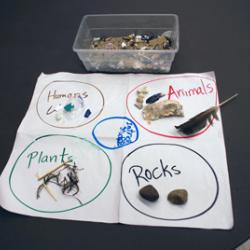Source Institutions
Source Institutions
Add to list Go to activity
Activity link broken? See if it's at the internet archive

In this activity, learners explore a bucket of sand and beach objects. First they sort items using observable characteristics, then they turn hard candy into "candy sand" to model where sand comes from. The lesson plan includes step-by-step facilitation instructions and questions to ask. It's written as a guide for use as an interactive exhibit or cart demo in a museum or aquarium, but it can be done by anyone who can get materials from a beach. The activity aims to get learners looking more closely at sand and other items on a beach, asking questions, and becoming more aware of how beach debris might harm organisms.
- Under 5 minutes
- 10 to 30 minutes
- $1 - $5 per group of students
- Ages 4 - adult
- Activity, Lesson/Lesson Plan, Model
- English
Quick Guide
Materials List (per group of students)
- Shallow plastic tub or shoe box
- Sand
- 15-20 pieces of beach debris: shells, tests of sand dollars, small rocks, feathers, trash (plastic, paper, corks, toys), coral, driftwood, seaweed, crab parts from a seafood dinner,
- Tray
- Large white chart or butcher paper
- Markers or crayons
- Tupperware or plastic peanut butter jar with lid (empty)
- Jolly Rancher hard candy or other assorted hard candy (4-5 different colors)
- *Optional, but helpful: Globe or world map poster, broom and dustpan, book on shells
Subjects
-
Earth and Space Science
-
Earth Structure
- Rocks and Minerals
- Oceans and Water
-
Earth Structure
-
Life Sciences
-
Ecology
- Ecosystems
- Human Impact
-
Ecology
Informal Categories
- Food and Cooking
- Nature and Environment
Audience
To use this activity, learners need to:
- see
- see color
- read
- touch
Learning styles supported:
- Involves hands-on or lab activities
Other
Includes alignment to state and/or national standards:
This resource is part of:
Access Rights:
- Free access
By:
Rights:
- All rights reserved, Regents of the University of California, Berkeley, 2009
Funding Source:
- National Science Foundation, NSF OCE-0731338
